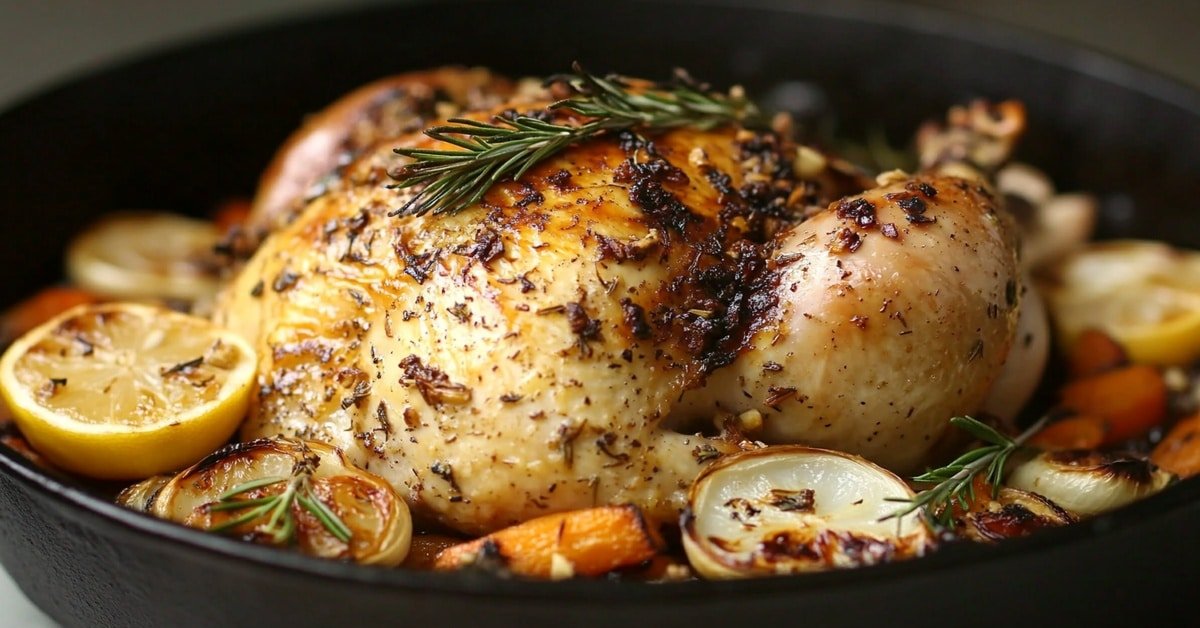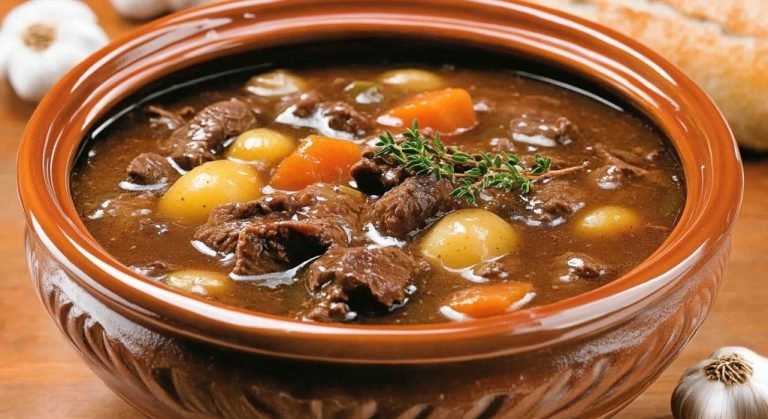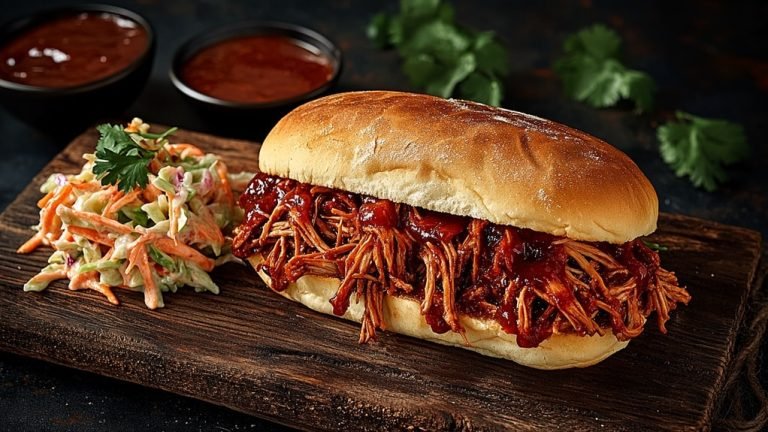Mastering a roast chicken in a cast iron skillet marries tradition with simplicity, offering an irresistible blend of crispy skin and juicy meat. Begin by preheating your oven to 450°F, ensuring a beautifully golden exterior. Pat your chicken dry, rub it with olive oil, and season generously with salt to elevate its natural flavors. Stuff lemon halves inside, and tuck in garlic cloves and rosemary sprigs for that aromatic touch. Place the bird over a bed of veggies in your skillet, letting them lift it for even roasting. As the kitchen fills with savory scents, prepare for an unforgettable dish that promises more delicious details.
Key Takeaways
- Preheat the oven to 450°F for crispy skin and even cooking.
- Use olive oil, salt, and lemon halves to enhance the chicken’s flavor.
- Place vegetables at the skillet’s base to act as a natural roasting rack.
- A cast iron skillet ensures even heat distribution for juicy meat and crispy skin.
- Experiment with herbs like rosemary and garlic for added depth of flavor.
History
Roasting a chicken is a time-honored tradition that dates back centuries, with roots in various cultures around the world. You might find it fascinating that this cooking method has been cherished by families for generations, as it not only brings people together but also transforms simple ingredients into a flavorful feast. Imagine the aroma of the perfectly roast chicken wafting through the air, evoking memories of warmth and togetherness. Each culture has its spin on the process, from the spices used to the cooking techniques that enhance the bird’s natural flavors.
As you prepare your roast chicken, think about how you’re continuing a legacy of hospitality and care. The cast iron skillet, known for its durability, plays a pivotal role in this culinary journey. It offers an even heat distribution that crisps the skin to a golden perfection while keeping the meat juicy.
As you season and stuff the bird, you’re partaking in a ritual that’s as much about nourishment as it’s about community. By choosing to roast a chicken, you’re not just cooking a meal; you’re honoring a rich tradition that connects you to cooks from centuries past.
Recipe
Roasting a chicken in a cast iron skillet is a time-tested method that results in a flavorful and succulent dish. The even heat distribution of the cast iron guarantees that the chicken cooks uniformly, while the high temperature helps achieve a crispy, golden brown skin. This straightforward recipe is perfect for both novice cooks and experienced chefs, offering a satisfying meal with minimal ingredients and effort.
Whether you’re preparing a weeknight dinner or an impressive dish for guests, this roast chicken promises to deliver delicious results every time.
The key to this recipe is simplicity, allowing the natural flavors of the chicken to shine through with the aid of a few basic ingredients. A whole chicken, seasoned with salt, pepper, and olive oil, is enhanced with aromatic elements like lemon, garlic, and rosemary. The vegetables at the base of the skillet not only add flavor but also serve as a natural roasting rack, elevating the chicken to guarantee even cooking.
This dish is certain to become a staple in your culinary repertoire, offering a comforting and satisfying meal for any occasion.
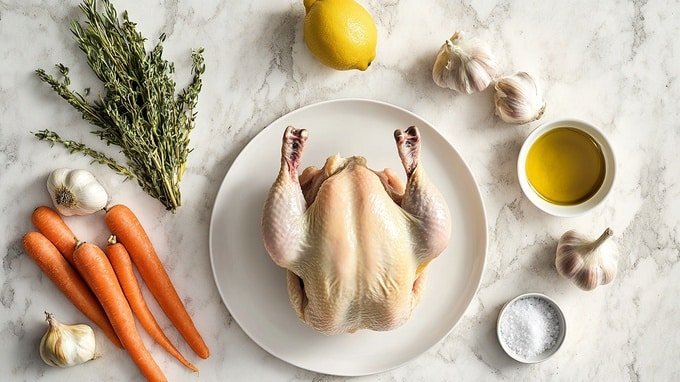
Ingredients:
- 1 whole chicken (3-4 pounds)
- 2 tablespoons olive oil
- Salt
- Pepper
- 1 lemon, halved
- 4 garlic cloves, crushed
- Fresh rosemary sprigs
- 1 onion, quartered
- 4 carrots, peeled and halved
To prepare this easy roast chicken, start by preheating your oven to 450°F (230°C). Pat the chicken dry with paper towels and rub it with olive oil, making sure to coat it evenly. Season the chicken generously with salt and pepper both inside the cavity and on the skin. Stuff the cavity with the halved lemon, crushed garlic, and a few rosemary sprigs.
Arrange the onion quarters and carrot halves at the bottom of the cast iron skillet, and place the chicken on top, breast side up. Tuck additional rosemary sprigs around the chicken for extra flavor. Roast the chicken in the preheated oven for about 1 hour, or until the internal temperature reaches 165°F (75°C) and the skin is golden brown and crispy. Let the chicken rest for 10 minutes before carving and serving.
For best results, make sure the chicken is at room temperature before roasting to promote even cooking. If you desire a more robust flavor, consider marinating the chicken in the refrigerator with your choice of herbs and spices for a few hours or overnight. Position the chicken breast-side up in the skillet to keep the breast meat moist while the legs cook through. Finally, save the delicious pan drippings to create a flavorful gravy or to drizzle over the chicken and vegetables for added moisture and taste.
Cooking Steps
To start your roast chicken journey, preheat your oven to a toasty 450°F, as this high heat will guarantee a crispy, golden skin.
Next, pat the chicken dry thoroughly with paper towels, which helps the skin crisp up nicely, then rub it all over with olive oil to give it a beautiful sheen.
Generously season the chicken with salt for flavor, and stuff it with lemon halves to infuse a fresh, zesty aroma throughout the meat as it roasts.
Step 1. Preheat Oven to 450°F
The oven is your trusty partner in achieving the perfect roast chicken, so set it to 450°F (230°C) to create a hot, even cooking environment. This temperature is essential for crisping the chicken’s skin while keeping the meat juicy and tender. The high heat is like a warm embrace, coaxing out the flavors and making sure that each bite is a delight. As your oven preheats, the anticipation builds, setting the stage for a meal that’s bound to impress and satisfy.
While you’re waiting, consider these helpful tips:
- Use an oven thermometer: Confirm your oven reaches the correct temperature, as not all ovens are precise.
- Position the rack in the center: This provides the most even heat distribution.
- Avoid opening the oven door frequently: Each peek lets out heat, which can impact cooking time.
- Prepare your ingredients: Having everything ready means less stress and more focus on the cooking.
- Think about presentation: A beautiful roast chicken is a centerpiece, so plan your garnishes for added appeal.
With your oven primed and ready, you’re on the path to serving a dish that’s both comforting and delicious, bringing joy to your table.
Step 2. Pat Chicken Dry Thoroughly
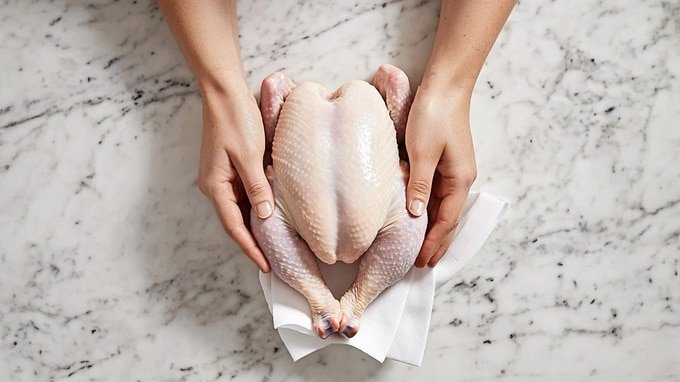
A clean kitchen towel is your best friend when it comes to preparing the chicken for roasting. As you get ready to create a delightful meal for family or friends, remember that patting the chicken dry is an important step you shouldn’t skip. Moisture on the skin can prevent it from crisping up to perfection, and a crispy, golden-brown skin is what you’re aiming for. Use the towel to gently press against the chicken’s surface, absorbing any excess moisture.
By doing this, you’re not just ensuring a beautiful, appetizing appearance, but also helping the flavors to adhere better. The dry skin allows for a more even application of seasonings, which is vital for a flavorful roast. Picture the chicken sizzling in the cast iron skillet, its skin turning a rich, golden color as it cooks. This simple step makes a big difference, transforming your roast from good to great.
Imagine the satisfaction as you serve the perfectly roasted chicken, its crispy skin a sign of your attention to detail. Your guests will surely appreciate the deliciousness born from this small yet significant task.
Step 3. Rub Chicken With Olive Oil
Begin by drizzling olive oil over the chicken, using your hands to rub it thoroughly onto the skin. This step guarantees the chicken remains moist and helps create that coveted crispy, golden-brown exterior. Feel the smooth oil glide across the chicken’s surface, making sure every inch is coated.
As you work, imagine the delight of those you’ll serve, knowing you’re crafting a meal with love and care.
- Enhances flavor: Olive oil enhances the chicken’s natural taste, adding a subtle richness.
- Promotes even cooking: Helps distribute heat evenly, leading to a tender, juicy result.
- Aids in browning: Encourages the skin to crisp beautifully in the oven.
- Simple, yet effective: Only requires your hands and a bit of oil, no fancy tools needed.
- A touch of tradition: Olive oil has been used for centuries in cooking, symbolizing warmth and hospitality.
As you rub the oil, consider how this simple act ties you to a long line of cooks who’ve used olive oil to enhance their dishes. This step is more than just preparation; it’s a moment of connection, anticipation, and culinary tradition.
Step 4. Season the Chicken
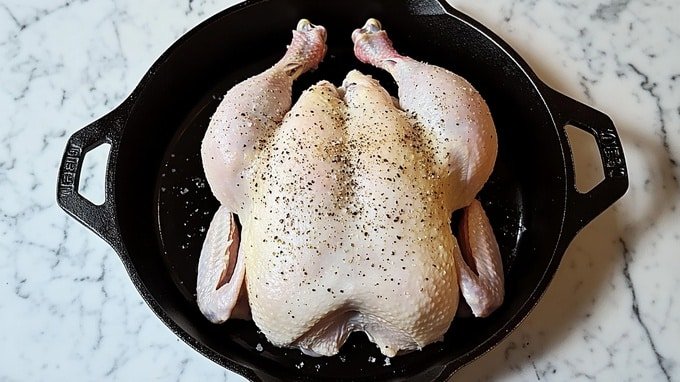
With a gentle sprinkle, season the chicken generously with salt to elevate its natural flavors. Salt is more than just a seasoning; it’s the hero that brings out the true essence of the chicken. As you scatter the salt, let it cascade over every inch, ensuring it clings to the skin and seeps into the meat.
This step is pivotal, as it not only enhances taste but also helps to draw out moisture, which in turn crisps up the skin beautifully as it roasts.
Imagine the transformation as your chicken basks in this simple yet potent ingredient. Salt has been a beloved companion in kitchens for centuries, revered for its ability to enhance any dish. By generously applying it, you set the stage for a meal that will delight anyone lucky enough to share your table.
As you season, consider the joy and satisfaction your guests will feel when they taste the perfectly balanced flavors.
Step 5. Stuff Chicken With Lemon
Having seasoned the chicken with salt, it’s now time to enhance its flavor profile by stuffing it with lemon. This step not only adds a burst of citrusy freshness but also keeps the meat juicy and tender during roasting. You’ll love how simple it’s to elevate your roast chicken with just a few ingredients. Follow these steps to stuff your chicken perfectly:
- Lemon halves: Cut a fresh lemon in half and place both halves inside the cavity. The juice and oils will infuse the meat with a delightful tang.
- Garlic cloves: Crush a few cloves and toss them in alongside the lemon. The aroma will complement the lemon beautifully.
- Fresh rosemary sprigs: Add a couple of sprigs to introduce an earthy, fragrant note that pairs well with the citrus.
- Ensure even distribution: Arrange the ingredients uniformly within the cavity to guarantee every bite is flavorful.
- Secure the cavity: Use kitchen twine to tie the legs together, keeping everything neatly inside as it roasts.
As you stuff the chicken, feel the textures and imagine the flavors melding together, creating a meal that’s not just delicious but also a joy to serve.
Discover helpful tips and techniques for mastering the art of cooking with cast iron in our comprehensive guide, How to Cook With Cast Iron, which will elevate your culinary skills and enhance your dishes.
Final Thoughts
Roasting a chicken in a cast iron skillet is a technique that combines simplicity with depth of flavor, making it a go-to method for both everyday meals and special occasions. With minimal ingredients and effort, you can create a dish that’s both impressive and satisfying.
The even heat of the cast iron guarantees a golden, crispy skin, while the juicy meat inside remains tender and flavorful. There’s something genuinely fulfilling about serving a beautiful roast chicken that you’ve prepared with care and attention to detail.
As you master this method, you’ll find endless opportunities to experiment with flavors. Try adding different herbs, spices, or aromatics to suit the tastes of those you’re serving.
Frequently Asked Questions
Can I Use a Different Type of Pan Instead of a Cast Iron Skillet?
Did you know 75% of professional chefs prefer cast iron for its heat distribution? You can use other pans, but cast iron guarantees even cooking and crispy skin, enhancing your dish’s ability to delight and serve others beautifully.
How Do I Adjust Cooking Time for a Larger Chicken?
To adjust for a larger chicken, increase the cooking time by about 15-20 minutes per additional pound. Always guarantee the internal temperature reaches 165°F. Your guests will appreciate the extra effort for perfectly cooked, juicy meat.
What Can I Substitute for Fresh Rosemary if Unavailable?
If you don’t have fresh rosemary, you can substitute with dried rosemary, thyme, or oregano. Each offers a distinct flavor profile that complements roasted chicken. Remember to use less dried herbs since they’re more concentrated. Enjoy serving!
How Should I Store Leftover Roast Chicken?
Coincidentally, storing leftover roast chicken lets you serve others even more. Place it in an airtight container, refrigerate within two hours of cooking, and use it within three to four days. It guarantees safety while keeping flavors intact.
Can I Add Other Vegetables to the Skillet?
Absolutely, you can add other vegetables to the skillet. Try bell peppers, potatoes, or zucchini for variety. These veggies not only enhance the dish’s flavor but also make it more colorful, delighting those you’re serving.

